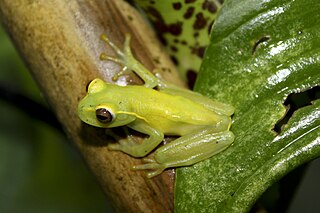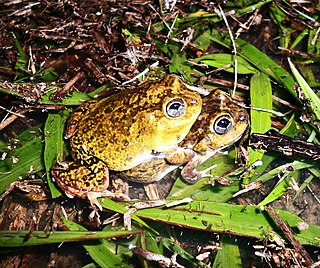
Pleurodema is a genus of leptodactylid frogs from South America. They are sometimes known under the common name four-eyed frogs, although this name can also refer to a particular species, Pleurodema bibroni. The common name is a reference to two inguinal poison glands that resemble eyes. When threatened, the frog lowers its head and raises its rear. When the frog adopts this posture, the poison glands are also raised toward the predator. The predator may also confuse the frog's raised posterior for the head of a larger animal.

The golden poison frog, also known as the golden dart frog or golden poison arrow frog, is a poison dart frog endemic to the rainforests of Colombia. The golden poison frog has become endangered due to habitat destruction within its naturally limited range. Despite its small size, this frog is considered to be the most poisonous extant animal species on the planet.

Phyllomedusa bicolor, the giant leaf frog, bicolor tree-frog, giant monkey frog, or waxy-monkey treefrog, is a species of leaf frog. It can be found in the Amazon basin of Brazil, Colombia (Amazonas), Bolivia, and Peru, and can also be found in the Guianan Region of Venezuela and the Guianas, and in Cerrado of the state of Maranhão in Brazil.

Colostethus panamansis, also known as the Panama rocket frog or (ambiguously) common rocket frog, is a species of poison dart frog. It is found in northwestern Colombia and Panama. It is one of the best studied poison dart frogs; however, until 2004 Colostethus panamansis was considered a synonym of Colostethus inguinalis, and consequently the older literature uses that name.

The granular poison frog or granular poison arrow frog is a species of frog in the family Dendrobatidae, found in Costa Rica and Panama. Originally described as Dendrobates granuliferus, it was moved to Oophaga in 1994. Its natural habitats are tropical humid lowland forests; it is threatened by habitat loss.

Lehmann's poison frog or the red-banded poison frog is a species of frogs in the family Dendrobatidae endemic to a small part of western Colombia. Its natural habitats are submontane tropical rainforests. It is threatened by habitat loss and collection for the pet trade, and the IUCN lists it as being "critically endangered". It was named after Colombian conservation biologist Federico Carlos Lehmann.
Minyobates steyermarki is a species of frog in the family Dendrobatidae endemic to Cerro Yapacana in southern Venezuela. It is also known by the common names of demonic poison frog, demonic poison-arrow frog, or Yapacana's little red frog. It is monotypic in the genus Minyobates.

The La Loma tree frog is a species of frog in the family Hylidae found in Costa Rica, Panama, and expected but not confirmed in Colombia. Its natural habitats are tropical moist lowland and montane forests, with breeding taking place in streams. It is threatened by habitat loss and chytridiomycosis.

Lithodytes is a genus of frogs in the family of Leptodactylidae. It is monotypic, being represented by the single species, Lithodytes lineatus, also commonly known as the gold-striped frog or painted antnest frog. It is found in tropical South America where it lives in humid forests among the leaf litter. These frogs build foam nests at the edge of temporary pools, and the tadpoles develop within these. The frogs also associate with certain leafcutter ants and breed inside their nests without being attacked by the ants.
Physalaemus deimaticus is a species of frog in the family Leptodactylidae. It is endemic to Brazil and only known from its type locality in Jaboticatubas, Serra do Cipó, Minas Gerais. The specific name deimaticus is derived from Greek deimos fror "fear" and refers to the defensive display of this frog, probably aimed at scaring predators. Common names Jaboticatubas dwarf frog and frightening foam froglet have been coined for it.
Pleurodema bibroni is a species of frog in the family Leptodactylidae. Its common name is four-eyed frog, although this name can also refer to the genus Pleurodema in general. The common name refers to two inguinal poison glands that resemble eyes. When threatened, the frog lowers its head and raises its rear. When the frog adopts this posture the poison glands are also raised toward the predator. The predator may also confuse the frog's raised posterior for the head of a larger animal.
Pleurodema borellii is a species of frog in the family Leptodactylidae. It is found in northwestern Argentina and southern Bolivia. The taxonomic status of this species is uncertain, and it may be a junior synonym of Pleurodema cinerea. It is abundant in Argentina, occurring in the Chaco-Yungas transition and montane grasslands on the eastern slopes of the Andes. Reproduction takes place in small permanent and temporary pools where pairs build floating foam nests. It is also found in disturbed habitats, including urban areas. No major threats to this species have been identified.

Pleurodema bufoninum, the large four-eyed frog, is a species of frog in the family Leptodactylidae. It is found in Argentina and Chile. Its natural habitats are subantarctic forests, temperate forests, subantarctic shrubland, temperate shrubland, subtropical or tropical dry shrubland, subantarctic grassland, temperate grassland, intermittent rivers, swamps, intermittent freshwater marshes, arable land, rural gardens, ponds, and open excavations. The common name "four-eyed frog" refers to two inguinal poison glands that resemble eyes. When threatened, the frog lowers its head and raises its rear. When the frog adopts this posture, the poison glands are also raised toward the predator. The predator may also confuse the frog's raised posterior for the head of a larger animal.
Pleurodema cinereum is a species of frog in the family Leptodactylidae. It is found in the Andes in northwestern Argentina, Bolivia, and southeastern Peru. Its common name is Juliaca four-eyed frog, after its type locality, Juliaca. Pleurodema borellii is possibly a junior synonym of this species.

Pleurodema diplolister, the Peters' four-eyed frog, is a species of frog in the family Leptodactylidae. It is endemic to Brazil. Its natural habitats are dry savanna, moist savanna, subtropical or tropical dry shrubland, subtropical or tropical dry lowland grassland, intermittent freshwater marshes, sandy shores, and pastureland. It is threatened by habitat loss. The common name "four-eyed frog" refers to two inguinal poison glands that resemble eyes. When threatened, the frog lowers its head and raises its rear. When the frog adopts this posture, the poison glands are also raised toward the predator. The predator may also confuse the frog's raised posterior for the head of a larger animal.

Pleurodema thaul, the Chilean four-eyed frog is a species of frog in the family Leptodactylidae. It is found in Argentina and Chile. Its natural habitats are subantarctic forests, temperate forests, temperate shrubland, temperate grassland, rivers, intermittent rivers, swamps, freshwater lakes, intermittent freshwater lakes, freshwater marshes, intermittent freshwater marshes, pastureland, plantations, rural gardens, urban areas, water storage areas, ponds, open excavations, sewage treatment areas, irrigated land, seasonally flooded agricultural land, and introduced vegetation. It is threatened by habitat loss.
Pleurodema somuncurense is a species of frog in the family Leptodactylidae. It is endemic to the Somuncura Plateau in Patagonia, Argentina.

The reticulated poison frog, known in French as dendrobate à ventre tacheté, is a species of poison dart frog. It is native to South America, where it can be found in Brazil, southeastern Colombia, Ecuador, French Guiana, and Peru.

Deimatic behaviour or startle display means any pattern of bluffing behaviour in an animal that lacks strong defences, such as suddenly displaying conspicuous eyespots, to scare off or momentarily distract a predator, thus giving the prey animal an opportunity to escape. The term deimatic or dymantic originates from the Greek δειματόω (deimatóo), meaning "to frighten".
Pleurodema cordobae is a species of frog in the family Leptodactylidae. It is endemic to the Sierras de Córdoba of Argentina. This endemic species also resides with the highly similar species, Pleurodema kriegi. P. cordobae exhibits particular characteristics that differentiate it from other frogs in the Pleurodema genus, including the fact that the species is octoploid, as compared to the P. kriegi and Pleurodema bibroni, which are tetraploid. P. cordobae inhabits temporary and semi-permanent ponds. As this species is only found in isolated locations such as the Sierra Grande, little is known about its very limited population.














